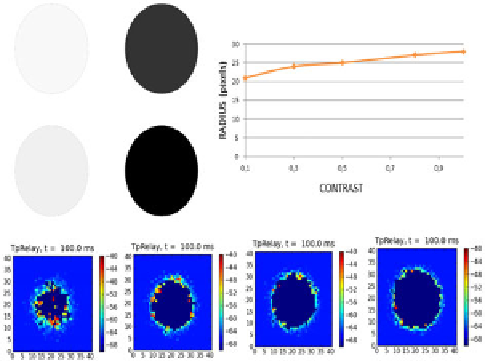Information Technology Reference
In-Depth Information
Fig. 4.
LGN processing depends on contrast. In the figure we can see different values
of contrast in our stimuli and the results for our simulations indicate that there is an
increase in the radius of the circular stimulus.
4.3
Impact of Tonic and Bursting Activity in LGN Processing
The thalamic relay cells respond to excitatory inputs in two different modes:
tonic and bursting mode. The behavior of both modes depends basically on the
calcium current known as
I
T
.
In the bursting mode,
I
T
is activated and an influx of calcium causes a depolar-
ization triggering a burst of action potentials. When the relay cell is depolarized
for
100ms or more,
I
T
tends to be de-activated and the cell fires in tonic
mode. The aim of this experiment is to analyze what type of filtering is carried
out in our LGN circuitry when the relay cell shows a tonic or a bursting activity.
Modifying the parameter
a
in the model AEIaf, we can simulate the behavior
of ion channels and therefore change the membrane potential. Values of a
>
0 hyperpolarize (potassium current) the membrane, activating the current
I
T
,
and therefore triggering the bursting mode. On the other side, values of a
<
0
depolarize (low threshold current of calcium) the membrane, thus inactivating
current
I
T
and therefore generating the tonic mode. The results obtained from
our simulations follow:
∼
-
When relay cells and interneurons show the tonic mode, we get a better
detection of the edges of our stimulus (Figure 5).
-
Time detection of the edges of the stimulus is reduced as the membrane
potential of relay cells and interneurons becomes more tonic (Figure 5).
-
When relay cells and interneurons behave simultaneously in the bursting
mode, there is a poor detection of the stimulus edges (Figure 6).
-
When relay cells and interneurons behave on modes tonic / bursting and
viceversa, the edges are best detected when the stimulus relay cells are work-
ing in tonic mode and the interneurons in bursting mode (Figure 6).

Search WWH ::

Custom Search